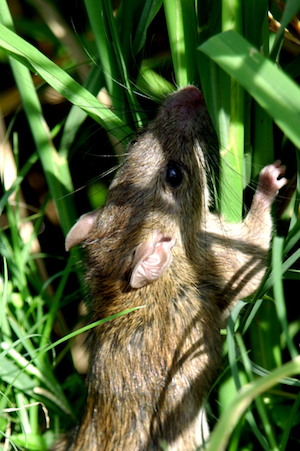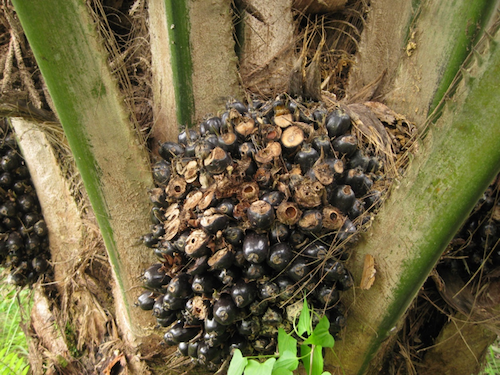Difference between revisions of "Sustainable Oil Palm Farming / Rats"
(Published from sandbox) |
(→Acknowledgements) |
||
| Line 134: | Line 134: | ||
[[Image:SNV logo.png|left|80px|link=http://www.snv.org/]] | [[Image:SNV logo.png|left|80px|link=http://www.snv.org/]] | ||
[[Image:wageningen university logo.png|left|350px|link=http://www.wageningenur.nl/en/wageningen-university.htm]] | [[Image:wageningen university logo.png|left|350px|link=http://www.wageningenur.nl/en/wageningen-university.htm]] | ||
| − | |||
| − | |||
Revision as of 23:10, 10 October 2016

Download: Module 5: Pests and Diseases
Rats (Rattus spp.) are an important pest in oil palm plantations (see Figure 1). They eat the leaf bases of young palms, sometimes even killing the palms. In older palms, rats eat from the ripening fruits in the bunches, causing damage (see Figure 2). When these bunches are sold at the mill a deduction will be given because some of the oil is lost. Rats reproduce very fast, so a small population can become a large one in a short period of time. Therefore, it is important to keep the rat population under control.
Contents
Goal
- To keep rat damage to fresh fruit bunches at a minimum;
- To keep rat populations under control.
Standard
- Rat damage to fruit bunches kept at less than 10 percent of the bunches damaged.
- Note: in smallholder plantations, rat baiting is useful only when neighbouring farmers also participate. Otherwise controlling rats by baiting is not effective.
Timing and frequency
- Monitoring of rat damage: once per two months.
- Rat baiting: when more than 10 percent of the palms/bunches are damaged, provided that neighbours are willing to participate.
- Installing barn owl boxes: Once, in the beginning of rehabilitation.
Labour time required
- Monitoring rat damage: As part of monitoring harvest quality.
- Rat baiting: 2 hours per hectare per round.
- Installing barn owl boxes: One day per five hectares.
Equipment and materials
- Barn owls, barn owl nesting boxes;
- Rat baits.
Who
Farmers and their families, in discussion with extension workers, cooperative and/or local plantation companies
How
Monitoring of rat damage
| Step 1. | In immature plantings (less than 3 years after planting), the plantation should be visited regularly (at least once per month) to check for signs of rat damage and rhinoceros beetle damage. |
| Step 2. | When harvesting productive palms, check bunches for rat damage. |
| Step 3. | If rat damage is observed in a harvested bunch (see Figure 2), all the other bunches should also be checked, and the percentage of damaged bunches noted. |
| Step 4. | If more than 10 percent of the bunches or immature palms show signs of fresh rat damage, it can be decided to take control measures. |
Biological control of rats
The cheapest, safest and easiest way to control rats is by biological control. Biological control of rat populations can be done by introducing barn owls (Tyto alba) (see Figure 3) or by conserving other predators, such as snakes. Such predators should not be killed unless they are a serious danger to workers or their families.
When using barn owls to control rats, the following points should be kept in mind:
- Discuss the best approach with an extension worker or with local plantation companies before introducing barn owls.
- Barn owls can usually be purchased on the market (if not, ask a nearby plantation where they bought their owls).
- Install nest boxes every five to ten hectares to get a good population of owls.
- Work together with other farmers to buy and keep the barn owls, especially if the plantations are small. You can also share costs.
Barn owls and other predators can help keep a rat population under control, but from time to time that the number of rats may still grow fast (an ‘outbreak’). If an outbreak occurs and the farmer decides to take action, it must be kept in mind that the poisons used to kill the rats can also harm the barn owls and other predators when they eat the poisoned rats. Farmers should think carefully before using poison, and make sure that they have all the information they need.
Chemical control of rats
If rats are starting to cause much damage despite the presence of owls, poisonous ‘baits’ can be used to kill the rats. Baits are, in fact, poisoned pieces of rat food, which can be bought in local shops. Note: these baits are poisonous also for humans, farm animals, and predators that eat the poisoned rats. They should therefore be used with care, and only if it is really necessary.
Baiting rats is only useful if the neighbours join in as well. Otherwise, rats from adjacent plantations will just move into the baited area after the baiting is done.
When using rat baits, the following should be kept in mind:
- Start with the mildest poison, the so-called ‘1st generation anticoagulants’ such as ‘racumin’, ‘warfarin’ and ‘chlorophacinone’ 2. Such 1st generation anticoagulants are less damaging to the barn owls and other predators, but it may happen that rats become resistant to them.
- If rats show signs of being resistant (see below) and the infestation is really severe, the farmer can try ‘2nd generation anticoagulants’. Common brands of such anticoagulants include ‘brodifacoum’, ‘bromadioline’ and ‘flocoumafen’.
Note: 2nd generation anticoagulants are damaging to barn owls and other predators and therefore should only be used as a last option. - Baits, once unpackaged, should be handled with care while wearing gloves, because they are poisonous to humans also.
- If goats or cows are grazing freely in the plantation, they may eat the baits and get poisoned. In this case, the baits should be placed in the palms, out of reach of the animals.
Rat baiting can be carried out as follows:
| Step 1. | If placing the bait on the ground:
If placing the bait on the palm:
|
| Step 2. | Note exactly how many baits have been placed, and check every 4—5 days to see how many baits have been eaten. |
| Step 3. | Replace any eaten baits with new ones until more than 80 percent of the baits remain uneaten, or until rat damage has declined to less than 10 percent of the bunches 1. |
| Step 4. | If many baits remain uneaten from the beginning, but rat damage to the fruit bunches continues, then the rats don’t like the baits and are not eating them. If this happens it might help to try another type of bait, or to buy fresh baits (if they have been stored for more than 6 months). |
| Step 5. | If many baits are eaten but rat damage to the fruit bunches continues, rats are likely to be resistant to the poison. Then, it may be necessary to switch to 2nd generation anticoagulants. |
Note: It is best to place baits directly after harvesting, so that the rats don’t have anything else to eat. Also, it is less likely that baits will be accidentally ‘collected’ with the loose fruits during harvesting. It is important to always tell the harvesters when rat baits have been placed in a plantation.
Data recording
Every rat baiting activity should be recorded in a logbook as shown in the example below.
| Date | Time | Location | Activity | Input type | Input amount | Input costs | Labour input | Labour costs | |
| People | Hours | ||||||||
| 16/01/13 | Field 3 | Rat baiting | Warfarin | 10 packs | 80000 | 1 | 2 | 20000 | |
References
- ↑ 1.0 1.1 IRRI photos, 2002, Field rats infesting rice plants, Wikimedia Commons, https://commons.wikimedia.org/wiki/File:Field_rats_infesting_rice_plants_%2811058917815%29.jpg, Accessed 20 July 2015.
- ↑ K.H. Lim, S.S. Lim, F. Parish, R. Suharto, RSPO Manual on Best Management Practices (BMPs) for Existing Oil Palm Cultivation on Peat., RSPO, Kuala Lumpur, Malaysia, 2012.
Acknowledgements
The material from Rats is sourced from Smallholder Oil Palm Handbook and put together by Lotte Suzanne Woittiez (Wageningen Universit) and Haryono Sadikin, Sri Turhina, Hidayat Dani, Tri Purba Dukan, and Hans Smit (SNV) in August 2016. See Module 5: Pests and Diseases for more information.





